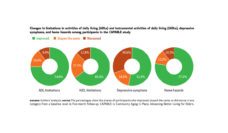Today, 10,000 people in the United States turned 65. Tomorrow, 10,000 people will turn 65. Every day for the next ten years, 10,000 people will turn 65.
The American population in rural areas is aging even more quickly than the rest of the country. The map shows the percentage of the population that is above 65 in each county in the US. The rural counties with a high percentage of older residents (dark green) outnumber the urban counties with a high percentage of older residents (dark blue). The average age in rural counties is seven years older than in urban counties due to trends in migration. Many seniors retire to rural areas to enjoy their natural beauty, slower pace of life, and lower housing costs. Nationally, young people are moving from rural areas and suburbs to urban centers as jobs shift. One third of the country’s oldest counties experience persistent population loss. Retirees moving to rural areas, while younger people move away, contribute to an aging rural population. From 1980 to 2016, the portion of the rural population over the age of 65 increased by 62%.
The healthcare infrastructure in the US is unprepared to support the medical needs of an aging rural population. In the past 10 years, 113 rural hospitals have shut their doors. Rural areas also face significant shortages in healthcare personnel. The Government Accounting Office estimates a shortage of 20,000 rural primary care physicians nationally by 2025. Rural patients must often travel significant distances to the few healthcare providers and hospitals in their areas.
An aging American population and rural healthcare shortages culminate in a major healthcare access gap for rural seniors. Limited access to care in rural areas is associated with poor health and high mortality rates for chronic conditions. Without significant government investment in rural healthcare infrastructure, rural seniors will die younger than their urban peers.
Databyte via Rural Aging in Place Toolkit, Rural Health Information Hub. 4 June 2019.














